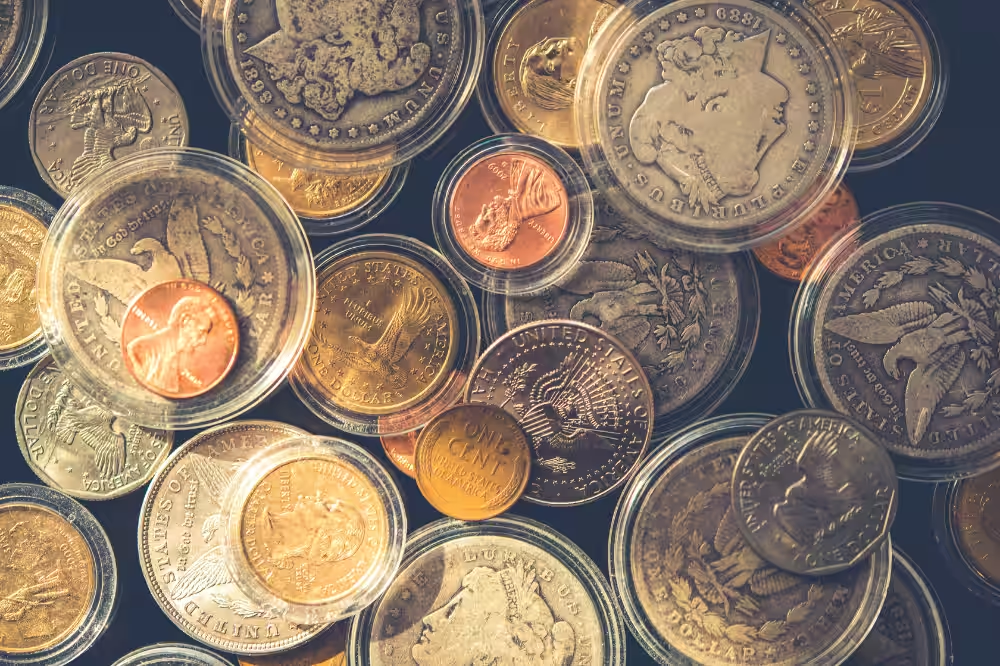Rare Coin Buying and Appraisal in Dallas
Discover the True Value of Your Rare Coins
Professional Appraisals • Expert Authentication • Immediate Cash Offers
Dallas Coin Buyers provides professional Rare Coin Buying and Appraisal services throughout Dallas, combining over 20 years of expertise with current market knowledge to ensure you receive fair value for your rare coins.
Understanding rare coins starts with recognizing that “rare” and “valuable” don’t always mean the same thing. A coin can be old without being rare, or rare without being especially valuable. Learning these distinctions helps you make informed decisions about your collection.
Building Your Understanding: What Makes Coins Rare
Think of rarity like a puzzle with several interconnected pieces. Each piece contributes to the final picture, but understanding how they work together helps explain why some coins command thousands while others remain affordable.
The Foundation: Mintage Numbers
Mintage refers to how many coins the mint originally produced. Lower mintages generally create rarer coins, but this represents just the starting point. A coin with a mintage of 100,000 sounds common until you learn that most were melted down or lost to time, leaving perhaps only a few hundred surviving examples.
Consider the 1909-S VDB Lincoln cent. The San Francisco mint produced 484,000 of these pennies, which seems like a large number. However, collector demand for this first-year Lincoln cent has made even this relatively high mintage feel scarce in the marketplace.
The Reality Factor: Survival Rates
Survival rates often matter more than original mintages. Coins face many threats over time including melting during precious metal price spikes, loss through circulation wear, and destruction through cleaning attempts or environmental damage.
The 1933 Double Eagle provides an extreme example. The mint produced nearly 450,000 of these gold coins, but government gold recalls meant virtually all were melted. Today, only a handful of legitimate examples exist, making survival rate the key rarity factor.
The Demand Element: Collector Interest
Collector demand creates the final piece of the rarity puzzle. Coins that collectors actively seek become functionally rarer in the marketplace than their actual survival numbers might suggest. This demand factor explains why some truly scarce coins remain affordable while popular but more common issues command premium prices.

Learning to Recognize Value: Key Date Identification
Understanding key dates forms the foundation of rare coin recognition. Key dates represent the coins within each series that command significantly higher prices than common dates from the same series.
Major Key Dates We Encounter
The 1916-D Mercury dime serves as a perfect teaching example. Mercury dimes generally trade for small premiums over silver value, but the 1916-D commands hundreds of dollars even in average condition. This single date’s rarity transforms an otherwise common silver coin into a significant collectible.
Similarly, the 1931-S Lincoln cent demonstrates how mintage and demand work together. While not the lowest mintage Lincoln cent, strong collector demand for complete Lincoln cent sets makes the 1931-S a required coin that commands substantial premiums.
The 1893-S Morgan dollar represents the ultimate key date in American silver dollars. Even heavily worn examples bring thousands of dollars because collectors recognize it as the single most difficult Morgan dollar to obtain.
Semi-Key Dates: The Hidden Values
Semi-key dates often provide the biggest surprises in collections because they’re valuable enough to matter but not famous enough for everyone to recognize. The 1924-D Lincoln cent, 1932-D Washington quarter, and 1950-D Jefferson nickel all fall into this category.
These semi-key dates teach us that rare coin knowledge extends far beyond the most famous rarities. Comprehensive evaluation requires understanding dozens of key and semi-key dates across multiple coin series.
Our Professional Rare Coin Buying and Appraisal Process
Understanding our evaluation process helps explain why professional appraisal produces more accurate results than online price guides or casual estimates.
Step 1: Authentication and Attribution
Every rare coin evaluation begins with confirming authenticity because counterfeiting unfortunately targets the most valuable coins. We examine each coin under magnification, checking for signs of alteration, cleaning, or modern reproduction.
Attribution involves identifying the exact variety, mintmark, and any special characteristics that affect value. Many valuable coins look similar to common ones, making precise identification crucial for accurate appraisal.
Step 2: Condition Assessment and Grading
Condition dramatically affects rare coin values, often determining whether a coin is worth fifty dollars or five thousand dollars. We assess wear patterns, surface quality, and eye appeal using professional grading standards.
Understanding how condition affects value helps explain our detailed examination process. A coin that appears “nice” to untrained eyes might show subtle problems that significantly impact its market value.
Step 3: Market Research and Valuation
Current market conditions determine actual values rather than outdated price guides. We research recent auction results, dealer networks, and collector demand patterns to establish fair market values.
This research component separates professional appraisal from simple price guide lookups. Market conditions change constantly, making current research essential for accurate valuations.
Step 4: Detailed Documentation
Professional appraisals include comprehensive documentation showing our identification, grading assessment, and valuation methodology. This documentation proves valuable for insurance, estate planning, or future sale decisions.
Understanding Grade and Value Relationships
Learning how condition affects rare coin values represents one of the most important concepts for anyone dealing with valuable coins.
The Grading Scale Explained
Professional coin grading uses a 70-point scale where higher numbers indicate better condition. However, understanding how this scale translates to actual market values requires recognizing that small grade differences can create large value differences in rare coins.
A 1916-D Mercury dime might be worth $800 in Good condition (G-4) but $3,000 in Very Fine condition (VF-20). This dramatic difference shows why accurate grading becomes essential for fair valuation.
Eye Appeal: The X-Factor
Eye appeal describes how attractive a coin appears beyond its technical grade. Two coins with identical grades can have significantly different values based on eye appeal factors like luster, toning, and overall visual impact.
This concept explains why professional evaluation involves more than mechanical grade assignment. Understanding eye appeal requires experience that develops through handling thousands of coins over many years.
Categories of Rare Coins We Evaluate
Understanding different categories helps explain the breadth of knowledge required for comprehensive rare coin appraisal.
Early American Coins (1793-1857)
Large cents, half cents, early silver, and gold coins from America’s first decades. These coins often show significant wear but command strong prices due to historical significance and scarcity.
Classic Gold Coins (1795-1933)
Gold eagles, double eagles, and other gold denominations that ended with the 1933 gold recall. Condition and rarity combine with gold content to create substantial values.
Key Date Silver Coins
Morgan dollars, Peace dollars, Walking Liberty halves, and other silver coins where specific dates command significant premiums over silver content.
Modern Rarities (1965-Present)
Error coins, low mintage issues, and special varieties that achieved rarity despite recent production. These coins teach us that age doesn’t determine rarity.
Proof and Commemorative Issues
Special production coins that often maintain premiums over their common counterparts due to limited production and collector demand.
Why Professional Appraisal Matters
Understanding the limitations of other valuation methods helps explain why professional appraisal provides superior results.
Online Price Guides: The Starting Point Problem
Internet price guides provide general ranges but can’t account for specific variety identification, accurate condition assessment, or current market fluctuations. They serve as starting points but not final answers.
Auction Comparisons: The Context Challenge
Auction results vary based on timing, marketing, condition differences, and bidder participation. Understanding how to interpret auction data requires market experience that casual sellers typically lack.
Insurance Appraisals vs. Purchase Appraisals
Insurance appraisals often reflect replacement costs that exceed actual market values, while purchase appraisals focus on current fair market value for immediate sale. Understanding these differences prevents unrealistic expectations.
Serving Dallas Area Collectors and Estates
Our Dallas location serves the diverse needs of rare coin owners throughout North Texas.
Estate Services: Families inheriting coin collections often need professional evaluation to understand what they’ve acquired and make informed decisions about preservation versus liquidation.
Collector Services: Established collectors use our expertise for insurance appraisals, collection assessment, and purchase decisions when upgrading or specializing their holdings.
Investment Evaluation: Individuals considering rare coins as investments benefit from professional guidance about market trends, liquidity factors, and realistic return expectations.
Legal and Professional Services: Attorneys, accountants, and estate planners rely on our documented appraisals for legal proceedings, tax planning, and estate settlement.
Why Choose Dallas Coin Buyers for Rare Coin Buying and Appraisal
Comprehensive Knowledge Base
Our expertise spans American coins from 1793 through modern issues, including varieties, errors, and special conditions that affect values. This broad knowledge ensures accurate identification and valuation.
Current Market Intelligence
We maintain active connections with auction houses, dealer networks, and collector communities to stay current with market trends and pricing fluctuations.
Professional Standards
Our appraisal documentation meets insurance and legal requirements, providing the thorough analysis needed for important financial decisions.
Immediate Purchase Options
Unlike appraisal-only services, we can provide immediate purchase offers for coins we evaluate, eliminating the need for separate selling processes.
Ready to Discover Your Rare Coin Values?
Whether you need professional appraisal for important planning decisions or you’re considering selling valuable coins, our expertise ensures accurate evaluation and fair treatment.
Understanding rare coins requires years of study and market experience. Let our knowledge work for you to identify valuable pieces, assess their condition accurately, and provide reliable valuations based on current market conditions.
Visit Us Today: Dallas Coin Buyers
Dallas, TX 75202
Phone: 469-754-8608
Get Your Professional Rare Coin Evaluationn
Expert Authentication • Detailed Analysis • Fair Market Values
Bring your rare coins to Dallas Coin Buyers today and discover their true value through professional evaluation. As your trusted coin dealer in Dallas, we provide the expertise and market knowledge needed for accurate rare coin assessment and fair purchase offers.
